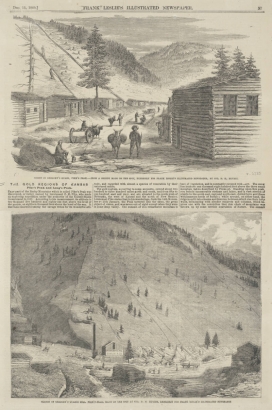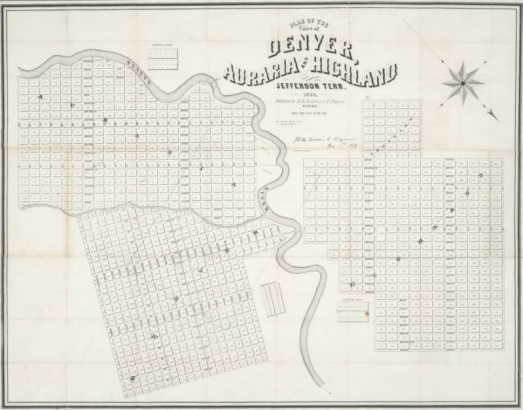On an April night in 1859, a raucous gathering took place at a saloon and gambling hall owned by Denver pioneer "Uncle" Dick Wooten. The purpose of the gathering was to garner support for a radical idea: creating a new territory known as Jefferson Territory, which would pull the Pikes Peak gold mining region into its own independent state. To the surprise of many, the idea actually caught on and within a few months, the Jefferson Territory was a functional political entity.
As you might have guessed, the dream of the Jefferson Territory died out and no one ever wound up living in the State of Jefferson. But the story of how a group of Colorado pioneers dreamed up their own, massive state and how it came to never be.
What's the matter with Kansas (Territory)
Before digging into the Jefferson Territory, it's worth taking a moment to look at the world around the tiny settlements of Denver City and Auraria in 1859. Back then, much of what we know today as Colorado, and all of what we know as Denver, was part of the Kansas Territory (K.T.). But the capitol of K.T. was nearly 500 miles from Denver and may as well have been located on another planet. Furthermore, with the nation in the throes of the bloody debate over slavery, the political machinations of the territorial government had little time for the concerns of Denver City and Auraria, two small settlements.
Being part of K.T. was also a minor concern for the people of the gold mining region that, although commonly referred to as the Pikes Peak, actually covered a huge swath of land that included parts of K.T., Utah Territory, Nebraska Territory, and New Mexico Territory. Those living in Pikes Peak gold mining region pretty much agreed that what mattered in K.T. wasn't always such a big deal to them, so they wanted to strike out on their. Besides, they figured, criminals probably wouldn't be too worried about standing trial in Fort Riley, K.T., for crimes committed in the wide open spaces of the Rocky Mountains.
But before they got too far, they had to make a decision. Did they want to be the Territory of Jefferson or the State of Jefferson? The difference between the two actions was that if they tried to jump to statehood, the people of Jefferson would have to fund themselves. (After all, states get some federal funding, but not for things like running state courts, etc.) If they decided to become a territory, the federal government would be doing the economic heavy lifting.
Not surprisingly, the good people of the Pikes Peak region, decided to try out being a territory. But just saying you're a territory, or want to be one, isn't quite enough. For starters, many settlers who were closer to K.T. were happy with things the way they were. There was also the not inconsequential matter of convincing Congress to officially recognize the Jefferson Territory.
To that end, the settlers of Denver City and Auraria sent H. J. Graham, who had been in Denver City only a couple of weeks at that point, to Washington, D.C. with a list of acquaintances to contact in Congress. Graham made his way to D.C. but didn't accomplish much while he was there. But that didn't stop the people of Jefferson from pressing forward with their plan.
Big Space for a Big Idea
Creating a new territory or state is a pretty big idea, so it's not surprising that the boundaries of the Jefferson Territory were pretty big, too. The official proclamation of the territory, as related in Jerome C. Smiley's History of Denver:
Resolved, That the State contemplated shall embrace the following territory, viz.: Its northern boundary commencing at the 102nd meridian of th e west longitude from Greenwich, Eng., with the 43rd parallel of north latitude, and running west on the said parallel to its intersection with the to its intersection with the 110th meridian of west longitude, thence south to the 37th parallel of north latitude, thence east on that parallel to the 102nd meridian, and thence north to the beginning; and that the name thereof shall be the State of Jefferson.
In layman's terms, that means Jefferson would have had the same southern boundary as present-day Colorado while its northern boundary would have stretched 138 miles into present-day Wyoming. The eastern border would have only been 2.7 miles further east, while the western border would have gone about 50 miles further west. Although it doesn't sound like all that much when expressed as words, the State of Jefferson would have been about 70 percent larger than the Colorado we live in today and would have encompassed parts of present day Wyoming, Nebraska, Utah, and Kansas.
So without approval of any kind from Congress, the citizens of the Jefferson Territory forged ahead. In November 1859, the first Jefferson Territorial legislative session took place in Denver. The first order of business was appointing Robert Williamson Steele, a Nebraska lawyer, to the position of Governor (fun fact: Steele was also responsible for naming Mount Vernon). During that session, 12 counties were incorporated into the territory, including Jefferson County, which is the only county from the Jefferson Territory to survive to the present day.
For the next year and a half, the Territory of Jefferson operated as an independent-though-renegade state with functioning courts and all the trappings of a political entity. But when the gold boom went bust, Jefferson lost much of its luster and potential. And when Kansas became a free state in 1861, Jefferson was left in tatters. Barely a month later, the Colorado Territory was recognized by the same Congress that never recognized Jefferson, and the dream died—living on only in the form of Jefferson County.




Comments
Thanks Brian. Really makes me
Thanks Brian. Really makes me yearn for those simpler times; and now I have to pretend that I don't live in JeffCo!
Thanks for the comment Peter!
Thanks for the comment Peter! JeffCo is pretty big on its own, but Jefferson Territory sounds even bigger!
For a researched view of the
For a researched view of the Hispano settlers living in Jefferson Territory, please see, "Pleas and Petitions: Hispano Culture and Legislative Conflict in Territorial Colorado." The book was printed by the University of Colorado Press in March.
And then the dream for
And then the dream for Statehood for Jefferson in the west coast died off, all because of a 1-day bad timing: Pearl Harbor. It seems that Jefferson was meant to never exist. I doubt it ever will. Even Alaska and Hawaii achieved Statehood afterward.
It never, ever would have
It never, ever would have made it through Congress. Pearl Harbor had nothing to do with it. Alaska and Hawaii were actual territories. "Jefferson" was part of two existing states with no compelling argument for being carved into a new, lowly-populated state.
Add new comment